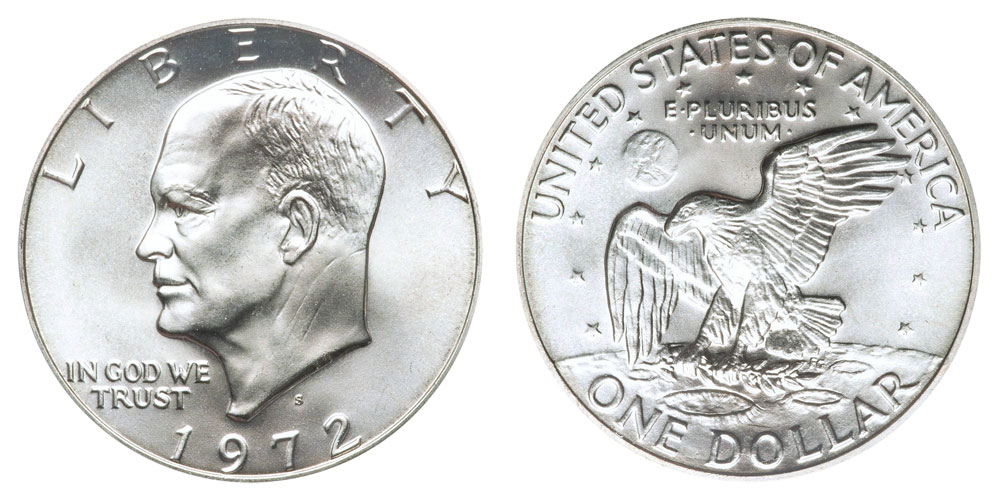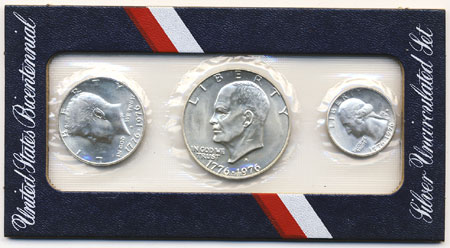Eisenhower Dollar Value
The Eisenhower dollar was a one-dollar coin issued by the United States Mint from 1971 to 1978; it was the first coin of that denomination issued by the Mint since the Peace dollar series ended in 1935. The coin depicts President Dwight D. Eisenhower on the obverse, and a stylized image honoring the 1969 Apollo 11 Moon mission on the reverse, with both sides designed by Frank. Eisenhower Silver Dollar Value Mint State examples of the 40% silver dollars from 1971-S to 1974-S are common through MS67-68 depending on the date – with the main exception being 1971-S that is. Eisenhower Dollars 1776-1976 D TYPE 1 $1 MS. NGC Universal ID: B76N. The NGC Universal ID is a four digit alphanumeric that groups coins based on a unique combination. Eisenhower dollars appeal to collectors on a variety of budgets. Many pieces challenge even financially well-heeled collectors. Prices for some key date Ike dollars reach into the thousands of dollars. Nonetheless, the majority of Eisenhower dollars are much more affordable to obtain. What follows is an Eisenhower dollar price guide.
Eisenhower Dollar Value by Date
Value Of 1971 Eisenhower Silver Dollar
Eisenhower Dollar Value Facts:
Date – Mint Rarity:

Eisenhower Dollar value is not dependent on key dates since there’s no key dates to be found in this series. Some people find the dual date 1776-1976 Bicentennial Ikes and think they’re rare, but such is not the case. You have to look into the varieties and condition grades to find the higher values, so most Eisenhower Dollars are worth $1, if you find them in a mint or proof set then they will be worth a few dollars.
Furthermore Eisenhower Dollars look silver but most are not, and when they are silver they’re clad in 40% silver. The 40% clad Ikes are found in blue envelopes, sealed in cello, and in brown boxes, housed in GSA type holders, and some were issued in Bicentennial sets with a quarter and a half dollar – all have “S” mint marks and each weigh 24.6 grams.
Grade – Condition:
Since Eisenhower Dollars are found abundantly in MS64 (Mint State) and lesser grades then the value is going to be low for these grades. The coins are large and that translates into more surface exposure to contact marks from other coins, even during the minting process, so they are worth only a few dollars or less when they’re MS64 and less. Raw coins rarely sell for more than $5 (most sell for $2 or less) so having them graded by a third party grading service will help the resell value.
However, if the coin does not grade at least MS65 then the submission fees far out-weight the value of the coin. You want to send Eisenhower Dollars that have the best chance at MS65 or better because their value can be upward of $150 for some dates and mints, but there’s some that need to come back MS66. In example, the 1974-D in MS65 is worth around $15 but in MS66 it’s value jumps to $120, so you wouldn’t want to send a 1974-D to be graded unless you’re certain it will be graded greater than MS65.
Varieties:

If you want value in your Eisenhower Dollars then you want to find and collect the varieties; but remember that even with varieties you want the mint state examples.
The 1971-S you want to look for what’s called the “Peg Leg” (a small tails extends off the R in LIBERTY) and those can sell for $50 in MS64. In 1972 you want look for the Type 2 Earth and the Type 3, but the Type 2 is the most valuable variety and can be worth over $1,000 in MS65. In 1776-1976 Bicentennial year look for the Thin Letter Reverse without a mint mark (Philadelphia) and this can be worth a few bucks in MS64 and up.

Also look for the 1971-D Tiger Claw and Happy Eagle and check all your 1974-D Ikes to see if they’re silver (not supposed to be).
1776 1976 Eisenhower Dollar Value
1971-S Peg Leg Eisenhower Dollar
Designer: Frank Gasparro, the reverse based on a design by Michael Collins and James Cooper Metal Content: Outer layers – 75% Copper, 25% Nickel, Center – 100% Copper 1776-1976-S Proof only 40% Silver Designer: Obverse by Frank Gasparro; Reverse by Dennis R. Williams Metal Content: Outer layers – 80% Silver, 20% Other, Center – 79% Copper, 21% Nickel Edge: Reeded Mint mark: None (for Philadelphia, PA) between Eisenhower’s head and the date. |
Large Dollars |
The Eisenhower Dollar was issued from 1971 to 1978. The obverse of the coin features Dwight D. Eisenhower and the reverse is based on the Apollo 11 mission insignia. For circulation, the coins were struck in copper-nickel clad composition, although “silver dollars” were also produced and issued for collectors. Despite the short duration of the series, the different compositions, varieties, and conditional rarities provide complexity and challenge for collectors.
The production of dollar coins had entered a lengthy hiatus after the final Peace Dollars were struck in 1935. By this time, the required production under the Pittman Act had been completed and abundant supplies were stockpiled which would last for decades. The denomination almost made a come back in 1964 when Congress authorized the production of new silver dollars, however, the entire quantity produced was recalled and melted before issuance. In the following year, the Coinage Act of 1965 would eliminate the silver content from circulating US coins and forbid the minting of silver dollars for a period of five years.
Following the conclusion of the five year period, the first legislation to create a new dollar coin was introduced in October 1969. The legislation sought to create a circulating dollar coin which would commemorate Dwight D. Eisenhower who had died earlier that year and the Apollo 11 space flight, which marked man’s first steps on the moon. A modified bill was eventually passed on December 31, 1970.
The Chief Engraver for the United States Mint Frank Gasparro designed both the obverse and the reverse of the coin. The obverse bore a profile bust of Eisenhower with inscriptions “Liberty”, “In God We Trust”, and the date. To prepare the design, Gasparro studied 30 pictures of the former President and Five Star General as well as a drawing he had made in 1945 after catching a glimpse of Eisenhower at a parade in 1945.
1978 Eisenhower Dollar Value
The reverse of the coin was based on the mission insignia from the Apollo 11 space flight. This was deemed particularly appropriate by Congress since the space program began under Eisenhower’s administration. The reverse design featured a bald eagle landing on the surface of the moon, carrying an olive branch, with the Earth visible in the background from space.
The new Eisenhower Dollars would first be issued for circulation on November 1, 1971. A few months earlier on July 1, uncirculated and proof versions struck in 40% silver were be available for collectors.
A different reverse design was introduced for the 1976 Eisenhower Dollar to celebrate the bicentennial of the American Revolution. The design by Dennis R. Williams featured an image of the Liberty Bell and the moon. The second element paid tribute to Gasparro’s original design, while the bell was included as a symbol of the liberty and freedom. The bicentennial reverse appeared on coins minted during 1975 and 1976, which all carried the dual date of “1776-1976” on the obverse.
Eisenhower Dollars were struck for circulation using the copper-nickel clad composition, which was also used for circulating dimes, quarters, and half dollars. The composition consisted of an outer layer of 75% copper and 25% nickel, bonded to a core of pure copper. The resulting net composition was 91.67% copper and 8.33% nickel.
Eisenhower Dollar Value 1972
As provided by the authorizing legislation, Eisenhower Silver Dollars were struck for collectors. Initially, a quantity of 150 million silver dollars was authorized for production over four years. These coins had an outer layer of 80% silver and 20% copper and an inner layer of 40% silver and 60% copper. The resulting net composition was 40% silver and 60% copper, with silver content of 0.3161 troy ounces. Authorization was later provided to produce bicentennial coins with the same composition.